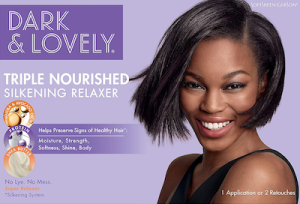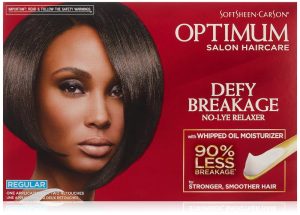Our product liability attorneys represent victims alleging that long-term use of hair relaxers causes uterine fibroids in all 50 states.
This litigation is very new. A medical study published just last year in October 2022 has been the driving force in the litigation. The study suggests that chemicals in hair relaxer products can significantly increase the risk of uterine cancer and uterine fibroids.
You may be entitled to settlement compensation if you used chemical hair relaxers regularly and have been diagnosed with uterine fibroids. We have been talking to women for the last three months, and so many of you have been through so much from uterine fibroids and never understood why. Now we know.
Hair Relaxers
Hair relaxers (or hair straighteners) are cosmetic products that force otherwise curly hair to flatten. In the U.S., these products are used primarily by Black women. It is a $9 billion industry. Applying a hair relaxer (often called getting a “perm”) is done at a salon or home every 6-8 weeks. Hair relaxers come in the form of creams, oils, or lotions. The product is applied to the base or root of the hair and allowed to sit there for a certain length of time. During that time, strong chemicals in the relaxer product attack the hair’s protein structure.
Hair relaxers use high concentrations of chemicals, including many chemicals that are known to be harmful to humans, such as phthalates. Phthalates are endocrine-disrupting chemicals (EDCs). The endocrine system produces essential hormones, such as estrogen, in women. EDCs are chemicals that disrupt the endocrine system’s balance causing abnormal hormone levels.
Uterine Fibroids
A uterine fibroid is a non-cancerous tumor growth in the uterus’s muscle wall. Uterine fibroids result from an abnormal overgrowth of the uterine muscle cells. Uterine fibroids can form as a single tumor, or there can be many of them. They range from as small as an apple seed to as large as a grapefruit. The suffering from uterine fibroids also varies from very little to horrific.
Fibroids are almost always non-cancerous tumors, but a cancerous uterine fibroid can occur in rare cases. Most women who develop uterine fibroids will never experience any symptoms at all. Approximately 1/3 of uterine fibroid cases will be symptomatic, with symptoms ranging from mild to severe.
The most common symptom of uterine fibroids is abdominal and pelvic pain or pressure. Abnormal uterine bleeding is also another common symptom. The pain associated with uterine fibroids can often be very severe. Surgery may be necessary when the pain caused by uterine fibroid is very significant.
Surgical treatment options include surgery to remove the fibroids (myomectomy). However, the only sure way to treat uterine fibroids is to surgically remove the entire uterus (hysterectomy).
Chemicals in Hair Relaxers Can Cause Uterine Fibroids
Although all women can get uterine fibroids, African American women are disproportionately impacted by this condition. Black women in the U.S. are three to four times more likely to develop uterine fibroids compared to women in other racial groups. Black women also tend to get uterine fibroids at a much younger age than women in the other racial groups. It is hard not to ask if hair relaxers were the reason why all along.
A developing body of scientific research has found that higher rates of uterine fibroids among Black women in the U.S. may be directly linked to exposure to chemicals in hair relaxer products (primarily used by Black women). The leading study on the link between hair relaxer use and uterine fibroids was published in 2012 in the American Journal of Epidemiology. Lauren A. Wise, et al., Hair Relaxer Use and Risk of Uterine Leiomyomata in African-American Women, American Journal of Epidemiology, Volume 175, Issue 5, 1 March 2012.
The study examined the health histories of over 20,000 pre-menopausal Black women in the U.S. over 12 years (1997-2009). The study’s results indicated that women in the group who used chemical hair relaxers regularly (particularly those who started using these products at a young age) were at much higher risk of being diagnosed with uterine fibroids than those who did not use relaxers.
The results of this study were further confirmed with the publication of another study in 2018 in the journal Environmental Research. This study examined the concentration levels of chemicals found in 18 different hair perm or hair relaxer products. The study found that the products contained numerous undisclosed toxic chemicals, many of which were banned in the EU.
Most recently, a University of Oxford study published in 2021 reported that Black women who used chemical hair relaxers a minimum of 7 times per year for 15 years or longer had a 30% increase in the risk of developing breast cancer.
The truth is the data showing the dangers of hair relaxers has been out there for a long time. Doctors (and lawyers) just were not paying attention. What changed the game? A study linking hair relaxers to uterine cancer was published in October 2022. This caused everyone to look at the risks of hair relaxers differently. While digging into uterine cancer claims, lawyers uncovered many women suffering from uterine fibroids. To be honest, our lawyers were shocked by the amount of pain and suffering – and the sheer number of hysterectomies – from complications from uterine fibroids.
Hair Relaxer Uterine Fibroids Lawsuit

Lawsuits are currently being filed against the cosmetic companies that manufacture chemical hair relaxer products. These lawsuits are being filed by women who used hair relaxer products, such as Dark & Lovely, for years and subsequently developed uterine fibroids, uterine cancer, or endometriosis.
The primary defendant in these lawsuits has been L’Oreal, which owns the Softsheen-Carson line of hair relaxer products. This includes popular brands such as Dark & Lovely, Optimum, and Softsheen. The lawsuits allege that L’Oreal and other manufacturers knew, or should have known, about the link between the chemicals in their products and uterine fibroids but failed to warn consumers.
In practical terms, L’Oreal is also a target because it is a massive company with a nearly $300 billion cap value. So the money is there to pay settlement amounts and jury payouts if this litigation is as successful as our lawyers expect it will be.
Hair Relaxer Class Action Lawsuit

A group of plaintiffs in some of the first hair relaxer product liability lawsuits filed a motion with the Judicial Panel on Multidistrict Litigation (JPML) asking for the hair relaxer cases in federal courts to be consolidated into a new class action MDL. L’Oreal and the other defendants opposed this request. But it was granted. All federal hair relaxer lawsuits are consolidated in Illinois. So if you file a hair relaxer lawsuit in federal court in Texas, California, New York, Florida, or any other state, the case will be transferred to Illinois.
Our hair relaxer lawyers are getting over 100 inquiries a day. Our law firm does not advertise. We just provide information to the victim. So, the point is this litigation will be massive. The hair relaxer lawsuit could ultimately have well over 100,000 plaintiffs.
Estimated Settlement Payout for a Uterine Fibroid Hair Relaxer Lawsuit
The hair relaxer lawsuits are new. So any settlement payouts estimates for hair relaxers are purely speculative. We could end the conversation here. But victims what to hear – deserve to hear – what lawyers project at this early stage for possible uterine fibroid hair relaxer settlement amounts. Victims in these cases are not children. They know our settlement amount projections are speculation. They want to know what that speculation is.
The expert evidence on the issue of causation is still being developed in these cases, so we don’t know whether it will even be admissible in court. Therefore, the settlement payout estimates below are based on several significant assumptions.
If the scientific evidence on causation is admissible, our attorneys estimate that hair relaxer lawsuits involving uterine fibroids as the primary injury could have a settlement payout value of around $150,000 to $500,000.
The settlement value of an individual hair relaxer lawsuit will depend mainly on the severity of the fibroids and the age and circumstances of the plaintiff. A hysterectomy during a childbearing age will likely drive settlement payouts higher. Our lawyers have seen cases where the woman’s life was destroyed and cases where the fibroids were managed quite well. Settlement amounts in hair relaxer suits will likely reflect their payout differences.
-
- Drilling down on what a hysterectomy hair relaxer lawsuit settlement payout might look like (and why our firm is only taking cancer claims at this time)
 Products Liability
Products Liability





